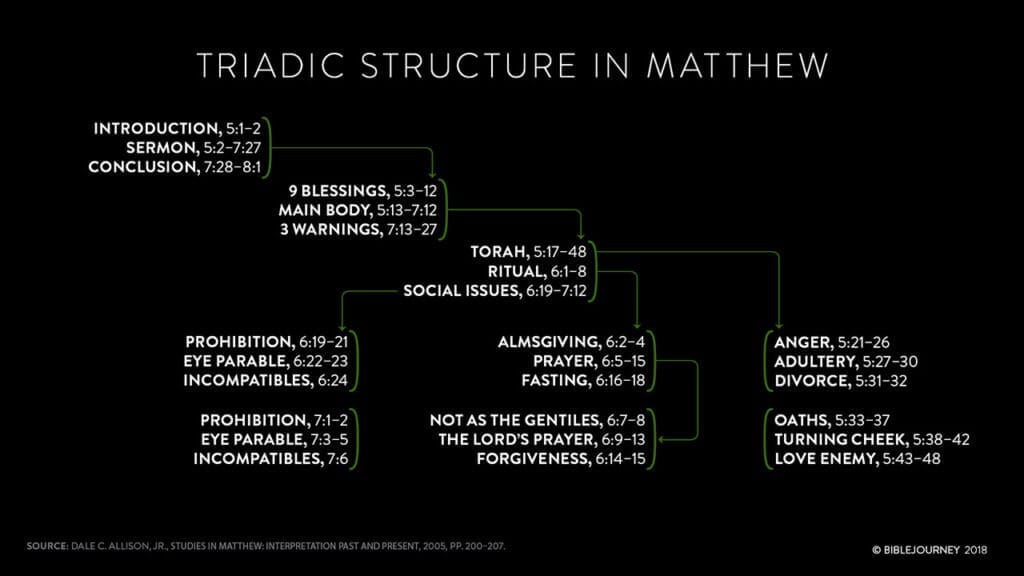The Gospel of Matthew
-
Lesson OneOverview of Matthew (Matt 1, 18, 27–28)13 Activities
-
Getting Started
-
Lesson Text: Matt 1, 18, 27–28
-
In | Workbook: Matthew’s Genealogy of Jesus
-
In | Key Features and Patterns in Matthew
-
In | Key Themes
-
In | Matthew and the Church
-
In | Workbook: Triadic Structure in Matthew
-
In | Workbook: Judas and the Old Testament in Matthew - The Betrayal of Jesus and King David
-
Behind | Gematria
-
Behind | Midrash
-
Behind | Jewish Liturgy
-
In Front | The Importance of the OT for NT Believers
-
Wrap-Up
-
Getting Started
-
Lesson TwoIsrael's Story and Mission (Matt 2–4, 11–15)15 Activities
-
Getting Started
-
Lesson Text: Matt 2–4, 11–15
-
In | Workbook: Moses and Joseph in Egypt
-
In | Typology
-
In | Ties to the Old Testament
-
In | Jesus as Fulfiller of the Mission of Israel
-
In | The Kingdom and the Fulfillment of Israel's Mission
-
In | Predictions, Prophecies, Promises and Foreshadow
-
Behind | Bethlehem
-
Behind | Jews and Gentiles
-
Behind | Onsite: A Threatened King - Herod's Palace Outside Bethlehem
-
Behind | Onsite: Judas and the Potter's Field - Echoes of Jeremiah
-
Behind | 360 View: Fishers of Men
-
In Front | O Little Town of Bethlehem
-
Wrap-Up
-
Getting Started
-
Lesson ThreeJesus and the Torah (Matt 5–7, 16–17, 23–25)18 Activities
-
Getting Started
-
Lesson Text: Matt 5–7, 16–17, 23–25
-
In | Jesus, the Teacher of Righteousness
-
In | Righteousness as Binding Community Value
-
In | Five Blocks of Teaching in Matthew
-
In | Walking in the Commandments
-
Behind | Takkanot
-
Behind | Alternate Views of Righteousness
-
Behind | Workbook: The Evangelical Triangle Rejects Jesus
-
Behind | Onsite: A Greater Righteousness - Jesus and the Sermon on the Mount
-
Behind | Binding and Loosing: Dr. Atef Ghendi
-
In Front | Exceeding the Righteousness of the Pharisees
-
In Front | Nonviolence and Nonresistance in the Sermon on the Mount Fulfilled in Jesus Passion
-
In Front | Workbook: Jesus Teaches Us to Pray
-
In Front | Matthew 23 and 2 Chronicles 24: The Lament over Jerusalem
-
In Front | Workbook: The Rhetorical Pattern of the Sermon on the Mount
-
In Front | Workbook: Jesus and Jeremiah's Prophetic Indictment of the Temple
-
Wrap-Up
-
Getting Started
-
Lesson Four"The Kingdom of God is Like..."10 Activities|2 Assessments
-
Getting Started
-
Lesson Text: Matt 8–10, 19–22
-
In | A Kingdom for the Little, the Least and the Children
-
In | Bible Project: Matthew 14–28
-
In | Christianity Today: What You Probably Don’t Know about ‘The Least of These’
-
Behind | Children in Antiquity
-
Behind | Onsite: Moving a Mountain - Herod's Palace Fortress at Herodium
-
Behind | Onsite: Gathering Disciples - Tax Collectors and Fishers of Men
-
In Front | Childlike Faith
-
Wrap-Up
-
Getting Started
-
Lesson FiveAuthor and Audience13 Activities
-
Getting Started
-
Lesson Text: Matthew review
-
In | Workbook: Matthew the Tax Collector
-
In | Authorship
-
In | Workbook: Great Commission
-
In | Bible Project: Heaven and Earth
-
Behind | Matthew's Jewish and Gentile Audience
-
Behind | Predictions, Prophecies, Promises and Foreshadow
-
Behind | Matthew 24 and Dating Matthew
-
In Front | Jews First, Gentiles Second
-
In Front | "Church" for Jew and Gentile
-
In Front | Workbook: Guiding Questions - Matthew
-
Wrap-Up
-
Getting Started
-
Course Wrap-upCourse Completion1 Activity|1 Assessment
In | Workbook: Triadic Structure in Matthew
Grab your Workbook Journal!
[Record your answers in the workbook provided at the beginning of this course.]
The Sermon on the Mount, given to a crowd on a hillside, is Jesus’ longest teaching recorded in the New Testament. Without recording devices or even scribes to write it down, it needed to be memorable.
One of the more common mnemonic devices in ancient times (and still today) involves assembling ideas or sayings in groups of three, called triadic structures. This device to make things memorable and easier to grasp is used in widely diverse works, from children’s stories (for example, “The Three Little Pigs”) to philosophical works (for example, Immanuel Kant’s The Critique of Pure Reason).
Because of its usefulness for packaging long or complicated ideas or teachings Jesus mapped the Sermon on the Mount in triadic structures in both its general outline and the different individual components.
- Carefully read Matthew 5:17-48 and record in your workbook any groups of three you notice.

Source: Dale C. Allison, Jr., Studies in Matthew: Interpretation past and present, 2005, pp. 200-207.
In the image above, you can see that triad structures are used throughout the Sermon on the Mount. They’re used not only in portions of the “body” of the sermon, but in the overall structure of the sermon.
Identifying these structures can be difficult, especially if you haven’t done it before. The more you learn to look for them the easier they become to find.
- Which sub-group of three in the graphic above do you find most striking or interesting, and why?